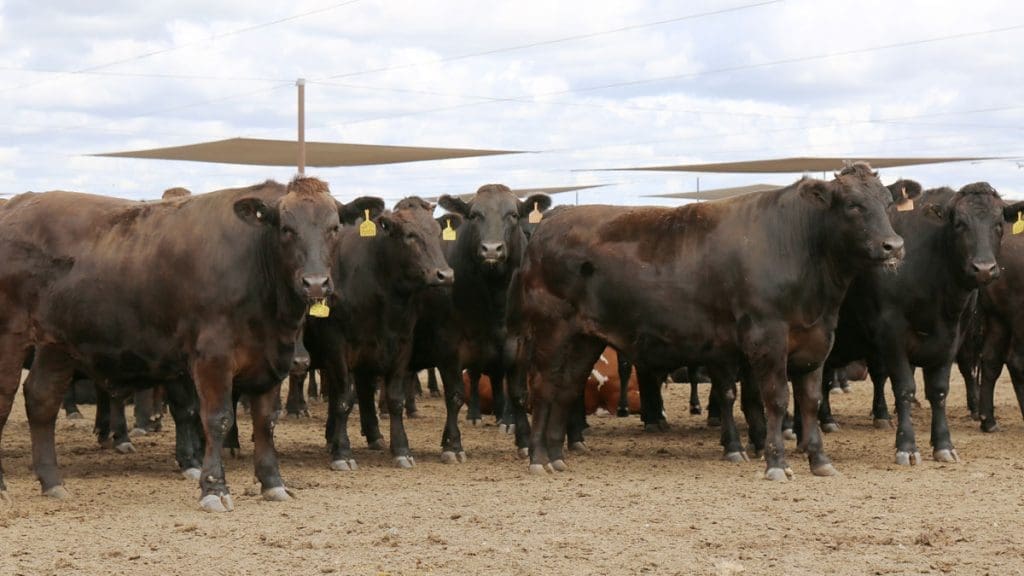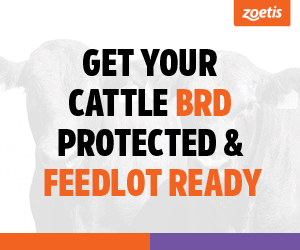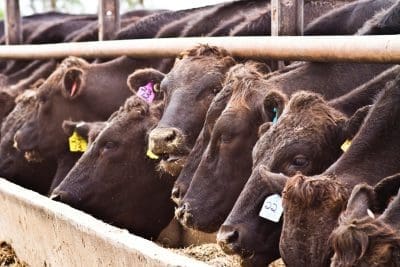
THE nature of lotfeeding cattle means that during periods of substantial livestock price decline, operators are left with animals on their books that can inevitably look very ‘expensive.’
That’s happened this year in spades, right across the spectrum of grainfed categories from domestic to longfed. But with one glaring exception, that added cost of production burden is now dissolving.
 Here’s a brief breakdown of the state of play for domestic, 100-day and longfed programs, based mostly on data provided yesterday by one of the nation’s largest grainfed supply chains on the Darling Downs.
Here’s a brief breakdown of the state of play for domestic, 100-day and longfed programs, based mostly on data provided yesterday by one of the nation’s largest grainfed supply chains on the Darling Downs.
For the purposes of this exercise, we’ve added 2-4 weeks to the feeding duration period to reflect the purchase and pre-feedlot entry phase. Thus for 100-day cattle, we’ve worked on 130 days (18.5 weeks) from date of purchase as feeders, to slaughter.
Unless otherwise described, we’ve used the NLRS feeder steer indicator for price guidance.
While feedgrain prices remain very high, significantly impacting profitability, the fact is the feeder purchase side of cost of production has now eased substantially for most, but certainly not all categories.
Here’s some examples:
Domestic 60-70 day grainfed:
By nature of their short feeding duration, 70-day domestic grainfed steers were the first to clear the negative impact of earlier extreme cattle prices.
By around June, domestic grainfed steers exiting the feedlot were already reflecting the substantial easing in feeder prices that’s occurred during 2023. Cattle heading to slaughter that week represented feeder purchases back in mid-August worth around 350c/kg – almost 90c/kg liveweight cheaper than three months earlier, when feeders were still worth almost 440c/kg.
100-day grainfed export ox
The process of ‘working through’ expensive feeder cattle took a little longer for 100-day programs, which as described earlier we’ve applied a 130-day timeframe from time of purchase to slaughter.
It meant for at least the first six months of 2023, 100-day grainfed beef was still bearing the burden of more extreme feeder prices seen earlier.
Based on records held by a large Queensland grainfed supply chain, July heavy feeder prices were still around 320c/kg, with the ‘really cheap’ cattle around 220-230c not emerging until late September/early October.
That’s an 80c/kg difference (worth around $500 on a 450kg steer) on July intake 100-day cattle heading to slaughter this week.
One large Downs lotfeeding business told Beef Central its July intake of 100-day flatback feeders had averaged 321c/kg, September 304c, and October back to 240c. Looking back further, December intakes last year averaged 428c/kg and January 393c/kg.
“It means that cattle dying from now through to Christmas all still carry feeder prices north of 300c,” the manager said.
While Downs feedlot quotes this week are back up around 265c/kg for 100-day feeders, due to recent rain, those October-November intake 100-day cattle, bought at the bottom of the price cycle around 230c, are not due to close-out until late March next year, carrying a much lower livestock price component of COP.
Longfed F1 Wagyu
The grainfed segment which is still bearing the full impact of last year’s extraordinary boom in feeder prices is longfed F1 Wagyu.
F1 Wagyu beef being processed this week, after a typical 360-380 day feeding program, represents feeder purchase prices in play in October-November last year.
 It might be hard to believe, given the context of what all feeder cattle are worth today, but lotfeeders running longfed F1 Wagyu programs were paying 980-1050c/kg liveweight for well-bred F1 feeder steers in October-November 2022.
It might be hard to believe, given the context of what all feeder cattle are worth today, but lotfeeders running longfed F1 Wagyu programs were paying 980-1050c/kg liveweight for well-bred F1 feeder steers in October-November 2022.
On a typical 450kg liveweight F1 feeder, that was an incredible outlay of $4725 a head.
One trade contact said with the possible exception of modest numbers of Fullblood Wagyu feeders sold in Japan, Australia’s F1 market in the last quarter last year was easily the dearest feeder cattle in the world, in living history.
The price got to such a point late last year that some Wagyu supply chains started to wave the white flag, despite solid international meat demand prospects at the time. Some resorted to buying sub-optimal Wagyu x Bos Indicus composite crossbreds at cheaper rates, instead of preferred Angus maternal lines.
One large company brought its offer price back into the high 9s for F1 feeders (mix of steer and heifer) in November/December last year, but plenty of others kept punching along at +1000c/kg.
January-March 2023 was certainly cheaper for good F1 feeders, but operators were still paying eye-watering prices then, in today’s context.
Months of pain still ahead for F1 programs
All this means that those grainfed supply chains dependent on longfed F1 Wagyu programs will continue to suffer from the impact of last year’s extreme feeder prices, until at least May-June next year.
Currently, good F1 Wagyu feeders are worth perhaps 330-350c/kg – about one third of their price seen this time last year.
But those cattle going on feed today, and closing-out after 360 days on feed (plus a few weeks’ gathering time) will not be turned into beef until the last few weeks of 2024, or early 2025.
All this means there is a heavy supply of Wagyu meat (and livestock in the later stages of their feeding program) out there, still carrying the legacy of incredibly high earlier feeder steer purchase prices.
“In fact we are probably in the absolute depths – the very worst of it – right now,” one supply chain manager said.
He said some supply chains may still be losing at least $1000 a head on longfed F1 Wagyu cattle being processed this week, with months of big losses still in front of them, until they drift into the first real ‘cheaper’ cattle that went on feed April-May this year.
“In terms of profitability on F1s being processed today, a lot depends on market access (China) and other factors, but there’s supply chains out there still losing four-figures on F1 cattle,” he said.
Flat international demand for highly marbled Wagyu beef has not helped the equation, as many consumers curb spending in a cautionary period of high living costs and economic uncertainty.
“Everyone is presuming that by May next year (when the feeder steer component of cost of production will move lower) there will be some margin, but that is still to play out – the international meat market for high quality beef is still quite subdued,” he said.
“Korea dropped out of the market nearly 12 months ago (government mandate to slaughter local Hanwoo cattle to curb inflation) and that has had a huge impact on demand for F1 beef. But beyond that, no customers are showing signs of wanting to increase business, at this stage,” he said.
China was particularly flat for high quality meat exports at present, he said.
“Worldwide, it appears that older and more affluent people continue to dine-out, while the middle class and younger consumers are very cautious at present with their spending. It’s the movies, rather than a nice steak dinner,” one supply chain manager said.
